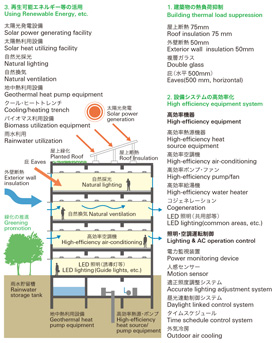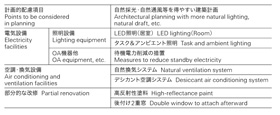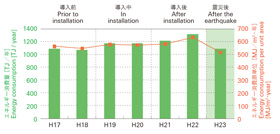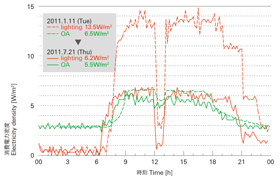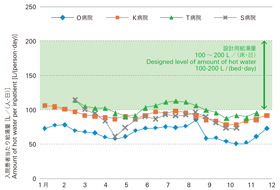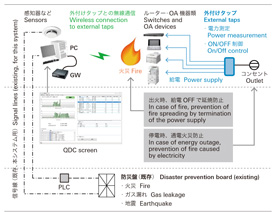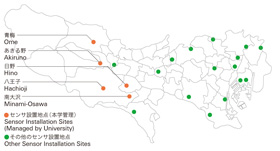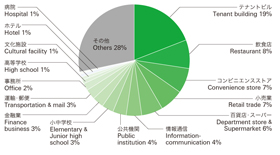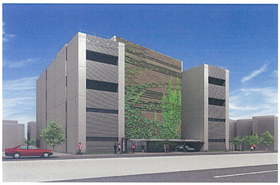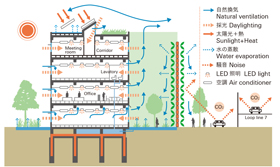・Achievement and Prospect of Project
This project, as leading work in the capital Tokyo, was a research project of proposing new energy efficiency specifications for the large-scale construction and renovation of public facilities in Tokyo. It aimed to apply the research findings to all the public facilities in Tokyo and to public and private facilities in Japan.
We conducted surveys and analyses of the use of existing facilities owned by the Tokyo Metropolitan Government and the status of the energy consumption. We also proposal for the reconstruction project of the building owned by Tokyo Metropolitan Government and measured and verified the effects, and conducted surveys and analyses to capture the climate characteristics in Tokyo.
During the 4-year project, the project members regularly communicated with the Tokyo Metropolitan Government and proposed new items and improvement of existing items. We developed, proposed , and reviewed the "Tokyo Energy Savings & Renewable Energy Specifications," which was a revised version of the "Tokyo Energy Efficiency Specifications 2007," and developed and proposed the "New Tokyo Energy Efficiency Specifications (tentative title)".
・Details of research achievement
1. Develop and propose "New Tokyo Energy Efficiency Specifications (tentative title)"
2. Survey and analysis of use of existing facilities owned by the Tokyo Metropolitan Government and actual energy consumption, etc.
・ Study on Energy Saving for High Schools in Tokyo
・ Study on the Use and Internal Heat Gains in a Large Government Office Buildings
・ Study on Hot Water Supply System in Hospital
・ Study on development of the next generation power supply system
・ Study on the evaluation method for measuring wood stock of a woody room
・ Study on Facility Management Ledgers in Local Governments
3. Survey and analysis of climate characteristics in Tokyo
4. Study on development of the analysis tool for contribution to energy-saving at mid-sized buildings
5. Proposal for the reconstruction project of the building owned by Tokyo Metropolitan Government, and measurement and verification of the effect
1.Develop and propose "New Tokyo Energy Efficiency Specifications (tentative title)"
"Tokyo Energy Efficiency Specifications 2007" sets out facility standards that Tokyo Metropolitan Government established in 2007 to change the public facilities in Tokyo, including government buildings, schools and hospitals, to the highest-level energy-saving buildings.
In 2011," Tokyo Energy Savings & Renewable Energy Specifications," which included the latest energy saving facilities and various renewable energy facilities, was established based on the results of this study for further improvement of the energy efficiency. After that, the project members kept discussing with the Tokyo Metropolitan Government and developed and proposed "New Tokyo Energy Efficiency Specifications (tentative title)"taking account of architectural planning considerations and reduction of standby electricity. Also, we created a guidebook with detailed research results to provide an easy-to-understand explanation of the specifications to engineers.
2.Survey and analysis of use of existing facilities owned by the Tokyo Metropolitan Government and actual energy consumption, etc.
Study on Energy Saving for High Schools in Tokyo
Surveys on the current situation and trend of the energy consumption at Tokyo municipal high schools showed that the consumption increases by about 10% annually by introducing cooling installation. The surveys and analyses of the specifications of the buildings and machines clarified that the improvement of the specifications and the reduction by operations are effective, especially thermal insulation, eaves, and lighting.
Study on the Use and Internal Heat Gains in a Large Government Office Buildings
Actual conditions of the internal heat gains from lights, occupants, and office appliances in the large government office building in Tokyo were surveyed to improve the accuracy of calculation of air conditioning loads. We also compared the consumed power density of lights and office appliances between before and after the 3.11 disaster and clarified its relation with the number of workers.
Study on Hot Water Supply System in Hospital
Actual conditions of hot water supply volume and energy consumption of hot water supply at four hospitals in Tokyo were surveyed to make appropriate design of hot water supply equipment. We also clarified that the current designed level of hot water supply was too high and its revision would lead to energy saving and cost reduction.
Study on development of the next generation power supply system
The actual condition of the standby electricity used in laboratories and office buildings was studied and a next-generation power supply system that could realize a power supply control at outlets was developed to reduce the standby electricity.
3.Survey and analysis of climate characteristics in Tokyo
To find climate characteristics in Tokyo (23 wards and Tama area) and reflect base data to "New Tokyo Energy Efficiency Specifications (tentative title)," we set meteorological observation systems in TMU (Minami-Osawa Campus and Hino Campus) and three Tokyo metropolitan high schools in Tama area and collected and analyzed meteorological data. In addition to the above sites, observation data (air temperature, relative humidity, wind direction, and wind velocity) obtained at about 15 sites in Tokyo where similar systems were introduced were compared, and we verified the difference in climate characteristics from data distributions in Tokyo.
4.Study on development of the analysis tool for contribution to energy-saving at mid-sized buildings
An energy database management system for small and middle size offices was developed by using the data in the Global Warming Countermeasure Report of the Tokyo Metropolitan Government, and the different uses of the buildings were analyzed. As reference for politically effective measures, primary energy consumption and CO2 emissions were calculated and energy type, primary energy consumption per unit, building size, and classification and the number of energy-saving techniques employed were calculated.
5.Proposal for the reconstruction project of the building owned by Tokyo Metropolitan Government, and measurement and verification of the effect
The project members were involved in the reconstruction of the government office building of about 3,000 m2 for the introduction of the technologies of "New Tokyo Energy Efficiency Specifications (tentative title)"and verification of the performance. The contribution started by making a proposal at the stage of the business selection. The members studied the detailed method and effects of the introduction of new specifications and examined future development.
Advice was given on the thermal insulation, eaves, natural ventilation, LED lighting, air conditioners, use of underground heat through foundation piles, solar power generation, BEMS or standby electricity reduction, and measurement systems. The construction began in October 2012 and finished in January 2014.
After the construction, the heat environment and the energy amount have been measured at the site.



